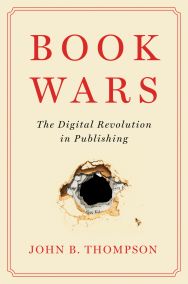Book Review
Dust jacket of Book Wars: The Digital Revolution in Publishing

I’m looking at a book on one of my shelves; written by a well-regarded historian for a general readership, it initially appeared in print in 2011. In the intervening ten years, the work has been released as a paperback, an e-book, and an audiobook, and, most recently, it has reappeared in the form of a handsome, slipcased volume produced by the Folio Society. Given that spectrum of available formats, one can’t help but assume that someone, somewhere, must be making a tidy profit.
However, if one reads Book Wars: The Digital Revolution in Publishing, by John Thompson, (Polity, 2021), the casual assumption is challenged.
Book Wars is itself a history, primarily focused on the disruption of mainstream publishing as it has unfolded over the initial decades of the twenty-first century. This disruption was not a single event; rather, it was a series of tumbling dominoes, created by technical innovation and resulting in cultural shifts in behavior.
Based on accounts from 180 C-suite executives and other publishing professionals, John Thompson’s documentation and analysis of events does the information industry a great favor. He details the introduction of Amazon’s Kindle device, the lawsuits over the Google Library Project and agency pricing, the rise of book-as-app, the growing acceptance of self-published content, and the desperate competition for the attention of the individual consumer on a multipurpose mobile device.
Thompson also shares with the reader statistical analyses of both public as well as private sales data from the industry. Of particular value is the statistical analysis appearing in the chapter on the explosion in self-publishing. Thompson’s work is authoritative and will be of tremendous value to future readers and researchers in understanding how a 500-year-old culture of print was able to absorb and adapt. I’m aware of no other title that provides such a useful account of how publishing professionals have fought to ensure stabilization and reliable delivery of content.
Think back to ALA Midwinter of 2020 and the heated exchanges between John Sargent, CEO of Macmillan, and librarians over an eight-week embargo that Macmillan had planned to introduce to library purchasing of electronic content. By introducing the embargo, Sargent sought to slow the immediacy of e-book access for library patrons, in the hope of driving those with sufficient interest to pay for it on their own. In the company’s view, they were being protective of author livelihoods and compensation, while ensuring that libraries were not paying sharply increased costs. Sargent referred to data held by Amazon indicating that e-books borrowed through the library essentially cannibalized sales of their front list titles to individuals. Librarians questioned that data, but nondisclosure agreements with Amazon prevented Sargent from providing more detail, and Amazon was and continues to be the only entity with that data. (Given the need for digital access during the long months of pandemic lockdown, it is important to stress that Macmillan did not implement the planned embargo for e-book purchasing by libraries.)
Of course, it’s not just the sales data that is of critical value. Dominating the e-book environment, Amazon holds the most comprehensive data set on individual content engagement for those publishers. Whereas major players in scholarly publishing have built their own platforms or have access to third-party hosting services with a supply of analytical data, trade publishers must strategize without full access to behavioral data. Shifts to alternative business models, such as subscription services or analytics, are less viable options.
Again, casual assumptions might have been that these trade publishers should have seen the digital disruption in scholarly publishing during the ’90s and moved more rapidly to rethink their business models. Thompson’s book explains some of the initial paralysis, which is all the more reason why I see it as a worthwhile title for inclusion in those academic library collections supporting graduate programs in either publishing or library science.
Referring back to the challenges that publishers face in negotiating with libraries, it’s worth noting that libraries are not feeling paralyzed. A press release from ALA, dated June 1, 2021, directs readers to a Joint Digital Content Working Group paper that “examines digital lending in public, academic, and K-12 school libraries. The paper notes current and long-standing challenges in digital content lending and the issues that complicate acquisition of, user access to, and preservation of digital information.” The paper is entitled The Need for Change.
Even more indicative of library activism was the flurry of press releases emanating from LYRASIS, a nonprofit with more than one thousand library members, focused on providing hosting options and technology systems to those members. First came news of the dissolution of an e-book collaborative partnership between LYRASIS and the New York Public Library. Then came the announcement of LYRASIS’ acquisition of library technology firm BiblioLabs, thereby strengthening their position with regard to e-book discovery. And finally came the announcement of the Palace Project, with its emphasis on ensuring equity of access. The June 28 press release describes it this way: The Palace Project, with a $5 million investment by the John S. and James L. Knight Foundation for LYRASIS, and in strategic partnership with Digital Public Library of America (DPLA), will develop and scale a robust suite of content, services, and tools for the delivery of ebooks, audiobooks, and other digital media to benefit public libraries and patrons.
It’s clear that the library community will insist on equitable treatment in the establishment of e-lending practices for the ebook to ensure that patrons are equitably treated. Legislators may agree with them, given that the states of New York and Maryland have legislation requiring that “publishers who offer to license e-books to the public” offer those same e-books to libraries on “reasonable” terms.
Book Wars: The Digital Revolution in Publishing emphasizes the eagerness with which trade publishing (previously reliant on a B2B economic model) is trying to build a B2C approach. Trade publishers want to engage with readers, developing more tightly targeted and personalized marketing in support of direct-to-consumer business strategies. Thompson’s research confirms that the Big Five (or is it Four) face significant challenges in balancing format demands of wholesalers, booksellers, and libraries while still locked into Amazon’s Faustian bargain. This is a risky business. Meanwhile, libraries are intent on gathering their own forces together in order to defend themselves and ensure patron needs are satisfied. The so-called book wars are not over.
